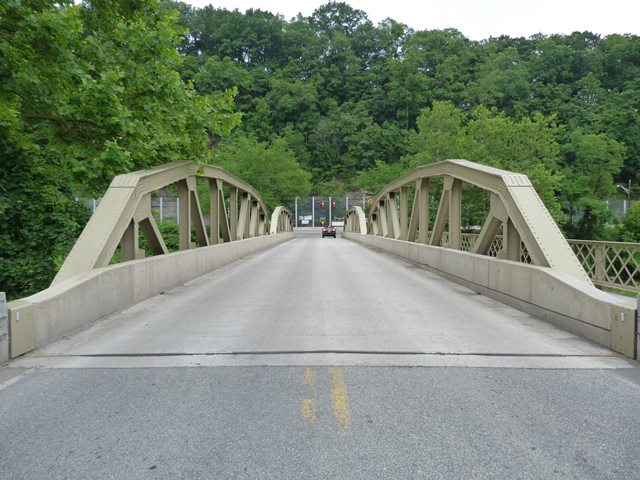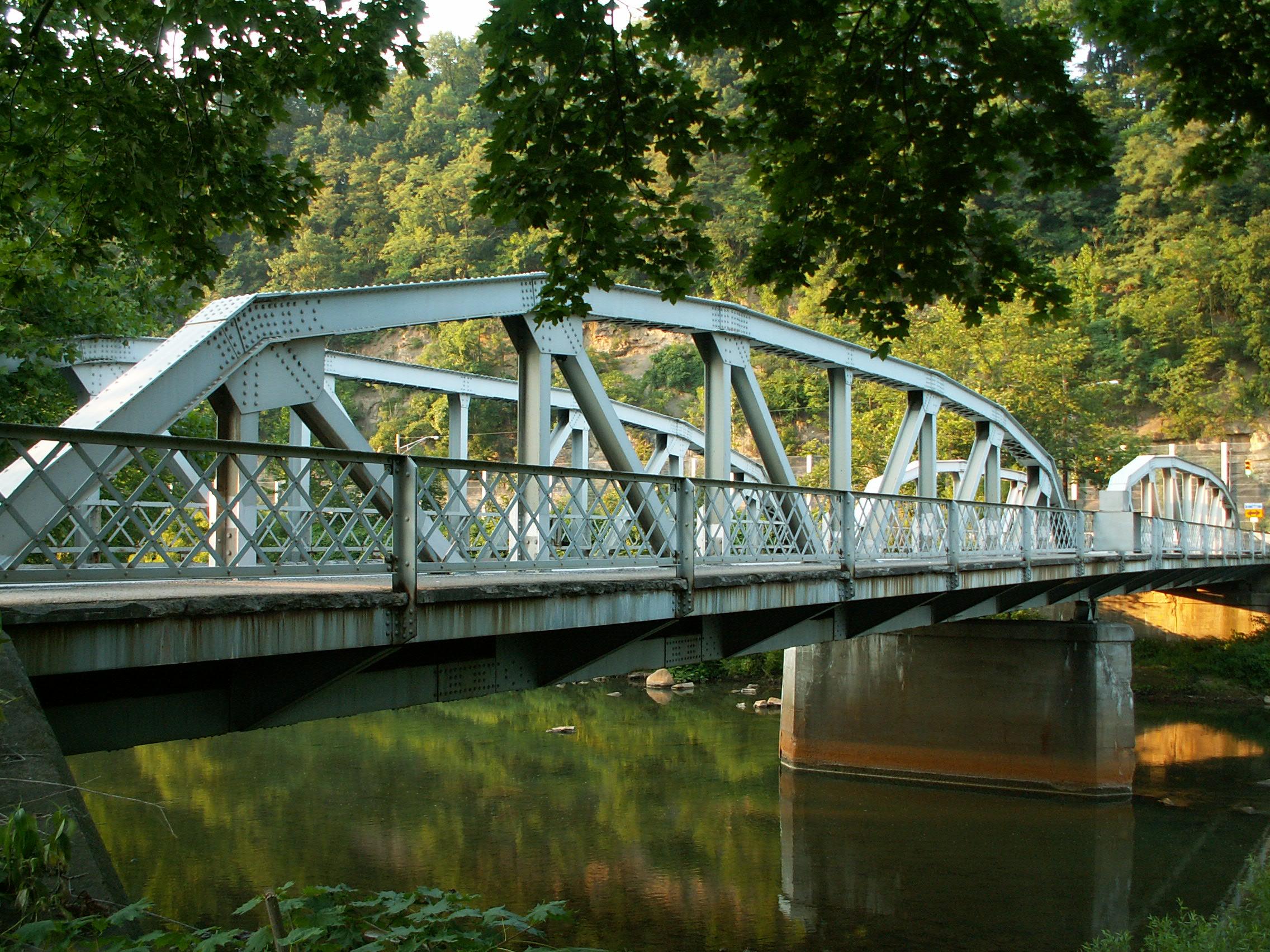We Recommend:
Bach Steel - Experts at historic truss bridge restoration.
Riverside Bridge
Eisenhower Boulevard Bridge

Primary Photographer(s): Nathan Holth and Rick McOmber
Bridge Documented: August 2007 and July 6, 2014
Ferndale and Riverside: Cambria County, Pennsylvania: United States
1937 By Builder/Contractor: Altoona Construction Corporation of Altoona, Pennsylvania and Engineer/Design: Pennsylvania State Highway Department
2010
113.0 Feet (34.4 Meters)
232.0 Feet (70.7 Meters)
23 Feet (7.01 Meters)
2 Main Span(s)
113006001000640

View Information About HSR Ratings
Bridge Documentation
View Archived National Bridge Inventory Report - Has Additional Details and Evaluation

This bridge is one of several standard plan type truss bridges that tend to date to the 1920s-1940 that are located in or just outside of Johnstown. Bridges like this one are often discarded by historic bridge inventories because they are declared undistinguished and common technology. Indeed, this was certainly the case when they were built. The fact that multiple examples of relatively similar design characteristics remain in Johnstown testifies to that fact. However, these bridges are rapidly being demolished and this is partly due to the fact that these inventories didn't even bother to consider their historic value.
Inventories should look at the fact that some of these older bridges may seem common when the inventory is taken, and then consider that even though this is the case, bridges like this are no longer being built today, and those that survive are being demolished. As such, even if the bridge is not all that rare today, it might be rare soon, and as such it should be declared historic. Perhaps the government should define a third designation for historic bridges that references bridges that are "prospectively rare and historic" meaning that as bridges are demolished, a particular bridge will then become more rare and historic. In addition, one must take into account that these bridges from this era, whether historic or not, are complex and beautiful structures that are a real asset to a city like Johnstown, and are also monuments to a city that was closely associated to the steel industry.

For a city the size of Johnstown, an unusually high number of metal truss bridges remain in the city. For this reason, these bridges should be considered part of a historic group, meaning that while an individual bridge may be of limited significance, the fact that so many are located in one city means that Johnstown is almost like a bridge museum. As such, the preservation of all metal truss bridges in Johnstown should be considered. The town already attracts tourists, particularly those interested in historic. Attractions include the Johnstown Incline Plane and the Cambria steel facilities. Creating a self-guided historic truss bridge tour might be something the city could consider in conjunction with a comprehensive preservation program that would ensure that all of the city's metal truss bridges are preserved. The city could also coordinate with the surrounding area, as a few bridges are located outside of city limits, but are still close enough to fit into this group of historic truss bridges.
The Eisenhower Boulevard Bridge is one of two nearby multi-span pony trusses, the other being the Krings Bridge. Multi-span pony trusses are relatively uncommon to find, which makes these two bridges interesting and noteworthy.
In 2010, this bridge was rehabilitated by PennDOT, which included a new deck and repainting the trusses with a standard three coat paint system. Overall, the rehabilitation appears have been well designed. It was nice to see that the original lattice railings were retained and not replaced, which is something that is sadly often not done in Pennsylvania. By choosing to rehabilitate this bridge, PennDOT has not only chosen to preserve an attractive historic bridge, they have also shown fiscal responsibility, since rehabilitation has traditionally been less costly than replacement. Located in PennDOT District 9, it is worth noting that District 9 has shown a slightly better track record than the rest of the PennDOT organization in terms of choosing to rehabilitate bridges instead of demolishing and replacing them. HistoricBridges.org hopes that the rehabilitation projects in District 9 will serve as inspiration elsewhere in the Commonwealth, and help to bring a positive change to the way historic bridges are treated.
Information and Findings From Pennsylvania's Historic Bridge InventoryDiscussion of Bridge The 1937, riveted, 2 span, Parker pony truss bridge is supported on concrete abutments and a concrete cutwater pier. Built to a state highway department standard design, the bridge is an example of a common technology with no innovative or distinctive details. It was erected as part of the rebuilding efforts following the devastating 1936 St. Patrick's Day flood. Over 275 bridges, mostly in the western and central portions of Pennsylvania, were destroyed or damaged beyond repair. To replace them the department turned to established technologies like riveted steel truss bridges, used in the state since ca. 1890. The bridge is neither historically nor technologically significant. Discussion of Surrounding Area The bridge carries a 2 lane road and a sidewalk over stream just south of Johnstown. The area does not have historic district potential. To the south is a T intersection with a 4 lane roadway and a steep rock wall. To the north is Riverside borough, an undistinguished mix of early 20th century to late 20th century residences and commercial buildings. Bridge Considered Historic By Survey: No |
![]()
Photo Galleries and Videos: Riverside Bridge
2007 Pre-Rehab Bridge Photo-Documentation
A collection of overview and detail photos. This photo gallery contains a combination of Original Size photos and Mobile Optimized photos in a touch-friendly popup viewer.Alternatively, Browse Without Using Viewer
![]()
2014 Post-Rehab Bridge Photo-Documentation
Original / Full Size PhotosA collection of overview and detail photos. This gallery offers photos in the highest available resolution and file size in a touch-friendly popup viewer.
Alternatively, Browse Without Using Viewer
![]()
2014 Post-Rehab Bridge Photo-Documentation
Mobile Optimized PhotosA collection of overview and detail photos. This gallery features data-friendly, fast-loading photos in a touch-friendly popup viewer.
Alternatively, Browse Without Using Viewer
![]()
Maps and Links: Riverside Bridge
Coordinates (Latitude, Longitude):
Search For Additional Bridge Listings:
Bridgehunter.com: View listed bridges within 0.5 miles (0.8 kilometers) of this bridge.
Bridgehunter.com: View listed bridges within 10 miles (16 kilometers) of this bridge.
Additional Maps:
Google Streetview (If Available)
GeoHack (Additional Links and Coordinates)
Apple Maps (Via DuckDuckGo Search)
Apple Maps (Apple devices only)
Android: Open Location In Your Map or GPS App
Flickr Gallery (Find Nearby Photos)
Wikimedia Commons (Find Nearby Photos)
Directions Via Sygic For Android
Directions Via Sygic For iOS and Android Dolphin Browser
USGS National Map (United States Only)
Historical USGS Topo Maps (United States Only)
Historic Aerials (United States Only)
CalTopo Maps (United States Only)


